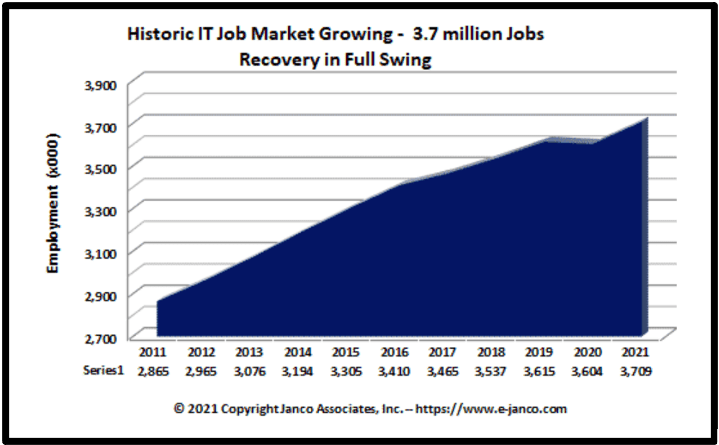 By Kathy Henrich
By Kathy Henrich
“I can’t find tech talent in Wisconsin!!” is a common exclamation.
While the concern is valid, it should be re-stated as “I can’t tech find talent in the Midwest, U.S., or anywhere!” This is an exaggeration, of course, but the truth is, recruiting tech talent anywhere in the United States is difficult.
We have a 1.5% national unemployment rate for technical talent.[1] And, the situation is not going to quickly resolve itself without purposeful investment.
First, how did we get here? Tech roles have continued to grow at an exponential pace. There are now 1 million more tech jobs, a 33% increase in the last 10 years.[2]

And, we have a “leaky bucket” for talent. In the overall economy in 2020, 10% more individuals retired than in 2019. [3] We are indeed experiencing the “great resignation” with historic rates in July/August, especially in tech and healthcare. Unfortunately, the highest rates are in our critically important mid-career demographic.[4]
We shouldn’t expect these trends to reverse anytime soon. As every business becomes increasingly fueled by tech, the demand for talent continues to grow. For example, of all jobs posted in 2021 in manufacturing, 38% now require tech skills including product development, agile, data analysis, python, software development and engineering, C++, SQL, and Linux.[5]
Increasing diversity of our tech talent must be focused on simultaneously. Study after study has shown that diversity increases innovation and financial returns.[6] Yet, women, Black/African American and Hispanic populations continue to be under-represented in our tech workforce according to CompTIA 2021.[7]
With these glaring challenges, how can we gain sufficient tech talent in Wisconsin to meet the talent requirements of our organizations? Integration of advanced technologies is critical to maintaining our global competitiveness. We must adopt a multi-faced approach to solving the issue:
- Collaborate to attract talent. The game for talent has changed. Individuals are deciding first where they want to live and second where they want to work. Factors such as quality of life, cost of living, and proximity to friends/family are driving the move.[8] Wisconsin has a leg up here IF we jointly promote the region
- Retain our current workforce. Our high-quality workforce is a target for companies not headquartered in Wisconsin. Retention should be a proactive strategy inclusive of employee engagement and competitive pay for tech talent.
- Embrace building tech skills through early talent and non-traditional tech talent routes. With a 1.5% unemployment rate and a “leaky bucket” of tech talent nationally, the regions that invest in building talent will be the real winners in the future. And individuals want to learn! We currently have more than 20 applicants for every tech apprenticeship role in southeast Wisconsin. The diversity of this candidate pool significantly exceeds the diversity of other talent pipelines. Building tech skills allows us to increase both capacity and diversity simultaneously.
Economic recovery in Wisconsin requires purposeful investment in building the skills for the future. Tech jobs drive innovation, tax revenue, and downstream economic spending. However, they are also portable. Therefore, we need to invest in our current workforce who are already invested in Wisconsin. We have the unique opportunity to “build back better.”
Kathy Henrich is the CEO of the MKE Tech Hub Coalition.
[1] https://www.comptia.org/content/tech-jobs-report
[2] https://www.e-janco.com/career/employmentdata.html
[3] https://www.shrm.org/resourcesandtools/hr-topics/talent-acquisition/pages/employers-face-hiring-challenge-as-boomers-retire-in-record-numbers.aspx
[4] https://hbr.org/2021/09/who-is-driving-the-great-resignation
[5] https://www.economicmodeling.com/wp-content/uploads/2021/08/The-Digital-Talent-Forecast_Ebook-1.pdf
[6] Diversity confirmed to boost innovation and financial results (forbes.com)
[7] CompTIA_Cyberstates_2021.pdf
[8] https://www.indeed.com/lead/tech-workers-survey-remote-work-working-from-home





